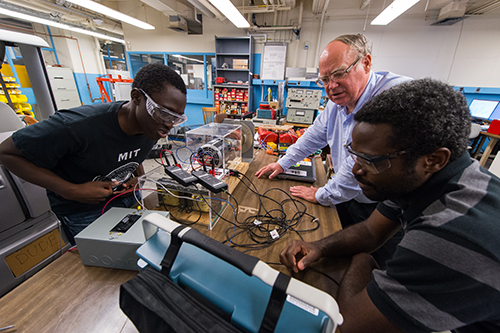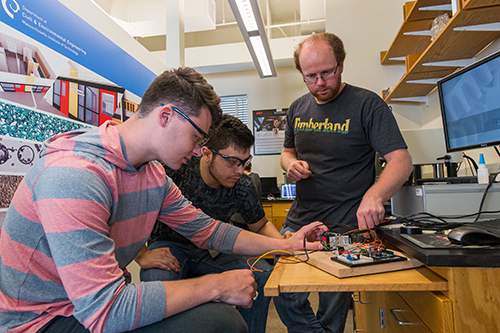
MIT students are increasingly bridging disciplinary boundaries as they pursue energy research opportunities, and the MIT Energy Initiative (MITEI) is finding new ways to accommodate and support their expanding interest.
During summer 2015, MITEI sponsored 42 projects through the Undergraduate Research Opportunities Program (UROP). Twenty-two of the projects involved students working with faculty outside of their home majors, and seven projects connected students and faculty from different MIT schools. Five years ago, merely a third of the 23 MITEI-sponsored UROPs engaged interdisciplinary student-faculty pairings, and only a handful were cross-school collaborations.
“Watching interesting partnerships arise between engineering students and architecture faculty, for instance, or mathematics majors and materials scientists, is really exciting for us,” says Amanda Graham, who was director of education for MITEI until autumn 2015. “It gets at the heart of our educational mission, which is building bridges and capabilities that bring disciplinary skills together.”
Cali Gallardo ’17 (Mathematics) found a project developing lighter-weight soundproofing material to improve fuel efficiency in cars and aircraft with Nicholas Xuanlai Fang, associate professor of mechanical engineering. “We liked Cali’s theoretical training as a math major, especially for designing and modeling acoustic composites,” says Fang. “But our lab also provides her with the opportunity to do hands-on work, so she’s not just solving equations.” Says Gallardo, “The UROP seemed like a good opportunity to explore a different field while doing a wide range of tasks, from building to computer-aided design.”
UROPs have been a mainstay of academic life at MIT since 1969. The vast majority of undergraduates seek out at least one opportunity during their four years at MIT to engage in significant research with a faculty member, earning credit or pay for work that might last a semester or even a number of years.
At MITEI, which has offered energy UROPs since 2007, the emphasis is on summer, when “students can perform the research full time and get a heck of a lot more done,” says Graham. Private donors, Founding and Sustaining MITEI Members, and MITEI Affiliates typically sponsor these projects, and MITEI cultivates contact between sponsors and students.
Akwasi Owusu-Akyaw ’17 (Mechanical Engineering) found the prospect of discussing his work with sponsor Lockheed Martin both “intimidating and exciting.” His summer research involved testing a design of a small, two-phase induction motor intended to be as powerful but more energy-efficient than comparable motors now on the market, which are used in products such as fans.

Owusu-Akyaw has been developing this device through sequential UROPs with James L. Kirtley Jr., professor of electrical engineering and computer science. It was Kirtley’s freshman seminar on energy generation and motor design that initially sparked Owusu-Akyaw’s interest: “I wondered about ways to increase power in motors, and I asked to get into his lab,” says Owusu-Akyaw. “I wanted to get into product design eventually, and the things you can do as a mechanical engineer are limited if you don’t know the electrical side.”
Given the demands of summer research work, MITEI offers one-on-one mentoring and other forms of assistance. Many of the students are just 18 or 19 years old and are holding their first jobs, and they may need “encouragement and a safety net,” says Ann Greaney-Williams, MITEI’s academic coordinator. And, adds Graham, while it may be ideal for undergraduates to work outside their home departments from a multidisciplinary education perspective, “it’s quite a lot to ask these students to be bridge builders.”

Supportive supervisors can help. Konrad J. Krakowiak, a research scientist in civil and environmental engineering, is managing undergraduates in aeronautics and astronautics and in biochemistry in a project on rocks involved in hydrofracking. “These kids are so great that I’m learning from them,” he says. “If we get interesting results, they will co-author any articles.”
At summer’s start, MITEI hosts an orientation session, bringing students together to meet each other and to learn about opportunities outside their UROPs. These include a series of workshops that Greaney-Williams introduced last summer and expanded this year “to offer career-based guidance related to energy, to give students skill sets, and to enhance their experience at school,” she says.
“I learned the most from the networking workshop,” says Reva Butensky ’18 (Materials Science and Engineering). “We practiced 60-second elevator pitches about our interests, skills, and experiences, and it taught me how to be confident about what I’ve done and what I hope to achieve.” This session, as well as workshops on resume writing and professional research presentations, provided “transferrable and valuable skills for internship searches and future career hunts,” she says.
Butensky was too busy with her UROP to attend MITEI workshops on stress reduction and conflict resolution. Under the supervision of Kristala Jones Prather, the Theodore T. Miller Associate Professor of Chemical Engineering, she has been learning to synthesize biofuels.
“I’ve been flying by the seat of my pants in a project that is intricately biology-based,” says Butensky, who has not taken a formal course in biology since middle school. But through her UROP, she says, “I’ve become intimately familiar with the field, problem-solving my way through advanced research.” After giving a wrap-up presentation at her lab, Butensky says, “I felt I had gained real insight into where future discoveries and technologies are going, and could be going, and it was extremely thrilling.”
This article appears in the Autumn 2015 issue of Energy Futures.